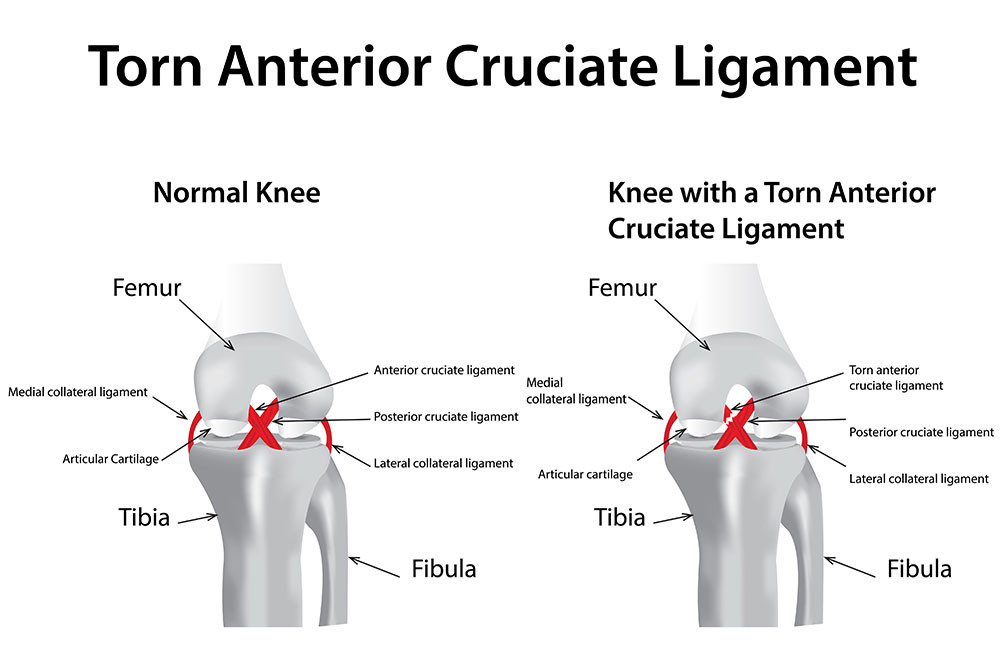ACL injuries

Anterior Cruciate Ligament Injury: Causes, Diagnosis, and Treatment
Unraveling Cruciate Ligaments
Cruciate ligaments, namely the anterior cruciate ligament (ACL) and the posterior cruciate ligament (PCL) are two essential ligaments found within the knee joint. They connect the thigh bone (femur) and the shinbone (tibia), playing a critical role in various movements such as running, jumping, and changing directions.

Anterior cruciate ligament (ACL) injuries are frequently observed among knee ligament injuries. They often result from sudden twisting or hyperextension of the knee, direct impact, or abrupt changes in direction during physical activities. Common causes include participation in sports such as basketball, soccer, and skiing. When the ACL tears, a distinct "pop" sound can be heard from the knee. Immediately following the injury, swelling and difficulty bending the knee arise, accompanied by redness, warmth, and pain in the joint. In some cases, patients may still be able to walk with some difficulty, but the knee may feel unstable or weak during movements that involve changes in direction. Additionally, standing up after squatting can be challenging.

How is an anterior cruciate ligament (ACL) tear diagnosed?
Orthopaedic doctors perform a thorough examination of the knee joint in patients suspected of having an ACL tear. Some patients may hear a loud "pop" sound immediately after an acute injury, which can cause concern about a possible fracture. However, approximately 70-80% of cases are actually attributed to an ACL tear. Doctors evaluate the degree of knee swelling and assess joint mobility to make a diagnosis, often confirmed during the clinical examination. An X-ray examination may be required if a fracture needs to be ruled out. An ACL tear can be classified as either a partial tear or a complete tear. Complete tears generally result in more pronounced symptoms and knee instability. When necessary, doctors may utilize MRI to assess the severity of the tear. Additionally, MRI imaging can be used to evaluate potential damage to the meniscus.
Treatment for an anterior cruciate ligament (ACL) tear
After an injury, patients must stop their activity immediately, apply ice to the affected area, and seek a comprehensive examination from a doctor. In cases of partial ACL tears, surgery may not be necessary. Conservative treatment is suitable for milder ACL tears or patients who are not eligible candidates for surgery. This treatment approach typically involves physiotherapy to restore joint range of motion and strength, along with the use of a stabilizing knee brace, which often produces satisfactory outcomes.
Surgical treatment can be considered for patients with a complete ACL tear or those who require a return to a high level of activity, such as athletes. Arthroscopically-assisted ACL reconstruction surgery is a minimally invasive procedure. During the surgery, the doctor harvests a tendon graft from another part of the body and utilizes arthroscopic techniques to secure the graft to the femur and tibia, replacing the torn ligament and restoring joint stability. Following the surgery, patients undergo a course of physiotherapy, and they generally regain their previous level of physical activity.
In cases where a torn meniscus is also present, minimally invasive knee surgery can be performed to repair or remove the damaged meniscus. This procedure significantly improves pain and restores a fuller range of motion.

Our Team
Virtus Orthopaedics and Traumatology Specialists
More:
-
Specialty - Orthopaedics and Traumatology
-
Rehabilitation - Orthopaedic Rehabilitation